#Iranian Graphic Design
Explore tagged Tumblr posts
Text
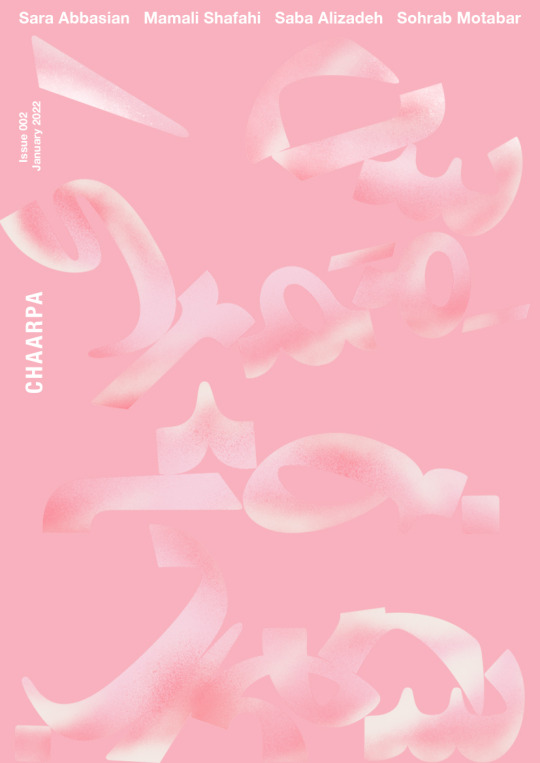
#POTK DESIGN#shahab tondar#chahab#typography#graphic design#persian typography#iranian graphic design#artwork
0 notes
Text

Sadegh Hedayat ::: The Blind Owl
3 notes
·
View notes
Text
It is an honor to have my work and artistic journey featured by the Honarnameh platform. I sincerely appreciate their professional team for their support and dedication to art and artists. I invite you to take a look at this feature.
#onish#onishaminelahi#aminelahi#onish_aminelahi#اونیش#اونیش امی الهی#اونيش امين الهي#اونیش امین اللهی#همرنگ#امین الهی آتلیه#iraniangraphicdesigner#iranian photographer#iranian art#iranian artist#iranian graphic designer#iran#usa
0 notes
Text

#graphics#book cover#graphic#book cover design#graphic design#narges mohammadi#narges#mohammadi#più ci rinchiudono più diventiamo forti#strade blu mondadori#mondadori#feminism#Jin#Jîyan#Azadî#jin jiyan azadi#Woman#Life#Freedom#woman life freedom#iran#persepolis#teheran#nobel prize#iranian women
1 note
·
View note
Text

The SR-71 crew who training in anti-SAM tactics left a 5-mile-long contrail in the stratosphere after dumping fuel for 10 seconds to see if the afterburner would ignite the fuel trail
The Blackbird
The SR-71, unofficially known as the “Blackbird,” is a long-range, advanced, strategic reconnaissance aircraft developed from the Lockheed A-12 and YF-12A aircraft. The first flight of an SR-71 took place on Dec. 22, 1964, and the first SR-71 to enter service was delivered to the 4200th (later 9th) Strategic Reconnaissance Wing at Beale Air Force Base, Calif., in January 1966. The U.S. Air Force retired its fleet of SR-71s on Jan. 26, 1990.

CLICK HERE to see The Aviation Geek Club contributor Linda Sheffield’s T-shirt designs! Linda has a personal relationship with the SR-71 because her father Butch Sheffield flew the Blackbird from test flight in 1965 until 1973. Butch’s Granddaughter’s Lisa Burroughs and Susan Miller are graphic designers. They designed most of the merchandise that is for sale on Threadless. A percentage of the profits go to Flight Test Museum at Edwards Air Force Base. This nonprofit charity is personal to the Sheffield family because they are raising money to house SR-71, #955. This was the first Blackbird that Butch Sheffield flew on Oct. 4, 1965.
During its operational lifetime, the SR-71 provided intelligence about the Yom Kippur War in 1973, the Israeli invasion of Lebanon in 1982, the US raid on Libya in 1986 and the revelation of Iranian Silkworm missile batteries in 1987. The USAF ceased SR-71 operations in January 1990.
Throughout its nearly 24-year career, the SR-71 remained the world’s fastest and highest-flying operational aircraft. From 80,000 feet, it could survey 100,000 square miles of Earth’s surface per hour.
SR-71 crews anti-SAM tactics
In 1968 the SR-71 crewmembers spent most of their time in the crew lounge, discussing anti-SAM tactics.
As told by Paul Crickmore in his book SR-71 Blackbird (Combat Legends), as the 9th Strategic Reconnaissance Wing approached the time when they would be flying out of the country at Kadena Air Base, Okinawa.
The SR-71 crew who training in anti-SAM tactics left a 5-mile-long contrail in the stratosphere after dumping fuel for 10 seconds to see if the afterburner would ignite the fuel trail

This print is available in multiple sizes from AircraftProfilePrints.com – CLICK HERE TO GET YOURS. Dawn at 80.000ft – SR-71 Blackbird
The plan was to penetrate enemy airspace at Mach 3. If fired upon, the pilot would accelerate to Mach 3.2 and climb, thereby forcing the missile’s guiding system to re-calculate the intercept solution. One idea was also to dump fuel to become lighter, thereby increasing the climb rate.
A 5-mile-long contrail in the stratosphere
A crew ended that debate during a Sortie over Montana by dumping fuel for 10 seconds to see if the afterburner would ignite the fuel trail. Instead, this turned instantly into an ice cloud in the fridge -55° C stratosphere and left a 5-mile-long contrail finger pointing directly at the aircraft.
The pilot reported that he could see the trail for hundreds of miles after turning back towards the west. That plan was scratched. That was the opposite effect, but they wanted regardless, the SR-71 was the first attempt at stealth in an airplane.
Be sure to check out Linda Sheffield Miller (Col Richard (Butch) Sheffield’s daughter, Col. Sheffield was an SR-71 Reconnaissance Systems Officer) Twitter X Page Habubrats SR-71, Instagram Page SR71Habubrats and Facebook Page Born into the Wilde Blue Yonder Habubrats for awesome Blackbird’s photos and stories.
@Habubrats71 via X
27 notes
·
View notes
Photo

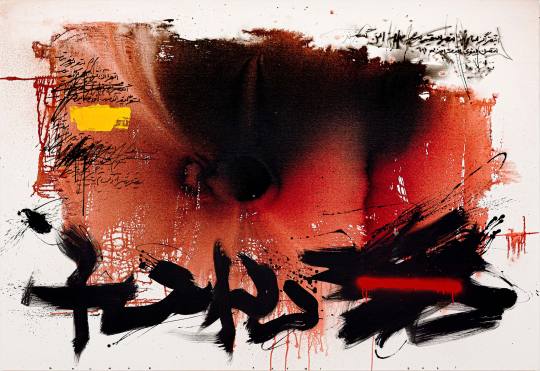
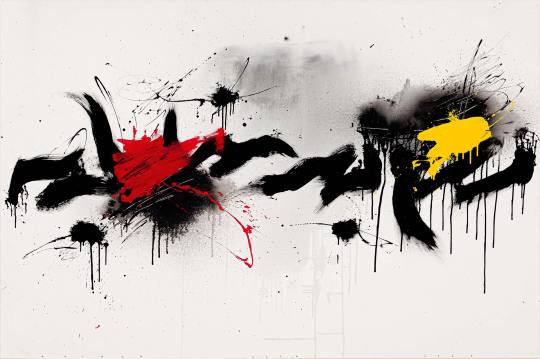
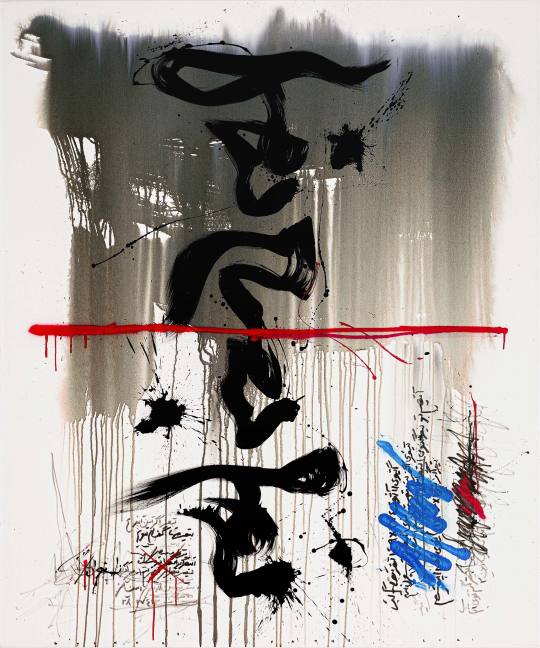

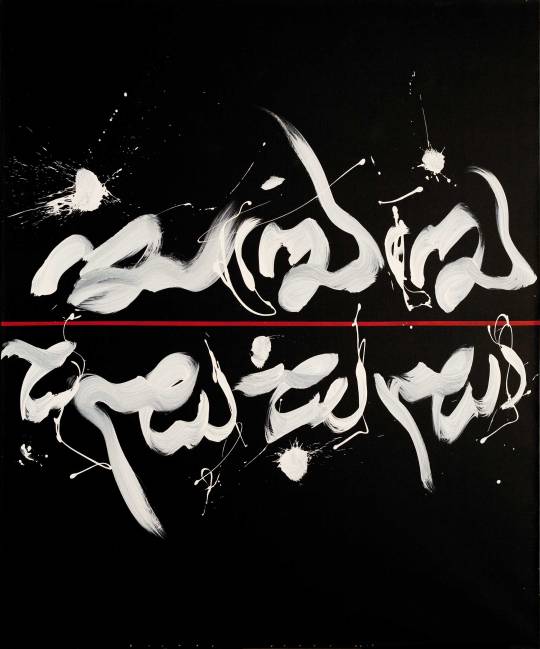
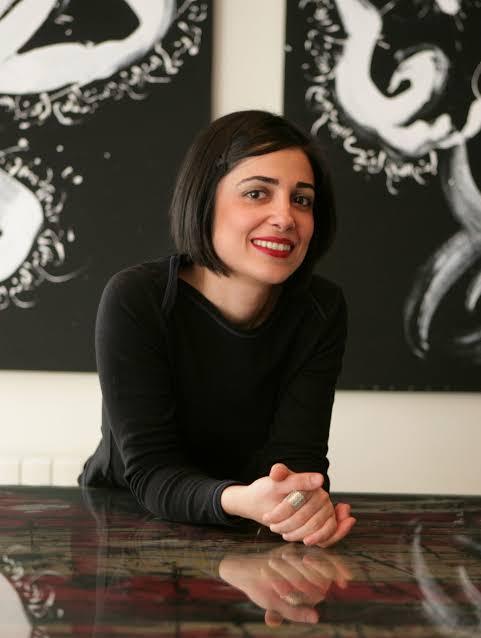
Born in 1972 in Tehran, Golnaz Fathi is a contemporary Iranian artist recognized for her reinterpretations of traditional Persian calligraphy. She studied graphic design at the Islamic Azad University and went on to study traditional Persian calligraphy, receiving a diploma from the Iranian Society of Calligraphy. She was named Best Woman Calligraphist by the Iranian Society of Calligraphy in 1995. She lives and works in Tehran.Fathi is widely recognized for expanding the tradition of calligraphy and pushing it to new heights.
Her works are inspired by American Abstract Expressionists and Iranian and Middle Eastern modernists, who pioneered the use of the written word as a pictorial element in the late 1950s and early 1960s. Technically brilliant, she has developed a new visual language, which reconciles the ancient with the contemporary. Fathi's interest in calligraphy derives from the medium's intention to match the visual beauty of a text with its content. Instead of communicating with words, she pushes the gestural qualities of calligraphy beyond language, into abstraction. Her works repeat forms, creating a meditative quality.
https://www.operagallery.com/artist/golnaz-fathi
178 notes
·
View notes
Text

Poster by Iranian graphic designer Moyamez, 1970s
8 notes
·
View notes
Text

So I was tryna figure out: how would the Younique staff fit into my little story?? Several of the characters have pretty cute looks, I didn’t wanna throw em away or make them terfs
well, solution!! For at least a couple of em, anyway.
reminder that TERFs literally CANNOT ALWAYS TELL that people are trans… they are so often wrong it is comical. A TERF bar could more than likely let in trans women without knowing or batting an eye… in my rewrite, Younique only profiled Ginger, Cherish, and Kaiya because they were so open and proud. Often why TERFs pick us trans folk out to begin with!! If you’re too proud, too open, too showy, they’ll try to take ya down. It sucks, but it’s why I’m so proud to be me. I’m so proud of my transgender siblings, because everyday we face the worst from society, and here we are, still standing.
I did change up Shanzay and Parniya’s styles quite abit… god, you can tell that there’s only *one* kind of lesbian Rusty thinks should exist. The diversity of women is a beautiful thing, and I wanted to show just how differently these two butch lesbians can present themselves, because there is more than one type of butch lesbian. (RUSTY.) People should dress how they’re comfortable, however the amount of characters were supposed to like who have the exact, plain style bothers me. People look different, even those within the same subcultures and similar presentations. I want to highlight that!!
Anyway, on to the character bios!!
Shanzay Binti Meriam!! Malaysian-Australian She/They, Transfeminine lesbian
Shanzay used to go to Younique with her girlfriend Parniya regularly, speaking with other regulars who took no issue with their trans identities. Shanzay is a confident woman who runs women’s martial arts classes with her girlfriend and her mother, Meriam. Unfortunately, after learning of the hateful incident at Younique regarding the GAP gang, Shanzay, Parniya, and several other regulars were horrified to learn of the hateful nature of a staff member of Younique. They took the issue to the owner, only to learn that this is standard behavior for the staff, and that a large majority of the staff are loud and proud transphobes. Shanzay and Parniya felt completely horrified that their less cis passing sisters went through this, not to mention that they had given their patronage to such a hateful business. They rallied many Younique regulars to take their leave, and to give their support to the GAP gang, giving their money to the PayPlease fund that would eventually help the girls open up GAP, their trans friendly nightclub. Shanzay now works for GAP as a bouncer, and is good friends with Kaiya particularly, bonding over their shared pride and love for their families.
Parniya Amira Gallus!! Iranian-Australian She/her, Transfeminine intersex lesbian
Standing at nearly 6’8, being transgender and intersex, and suffering from chemical burns at a young age, Parniya is not a very average looking woman. She is very quiet and mellow, and doesn’t wish to draw much attention to herself. Because of her wallflower nature, it’s no shock that the transphobic staff of Younique looked right past her and her girlfriend Shanzay whenever they walked in. Parniya identifies as a butch lesbian, though she still embraces her feminine side often. After finding out about Younique’s transphobia against the GAP gang, Parniya was particularly shaken. Even after rallying other regulars to leave with her and Shanzay, Parniya doesn’t go out nearly as often anymore. She wears much more makeup now, perhaps in an attempt to pass more, like she believes she will run into Younique staff again. Parniya does remote graphic design for GAP, and as a result is well acquainted with Theodosia, and has quickly become good friends with her. They bond over a shared love of old princess stories, as well as their passion for art and other women.
#angelicmelon#disabled artist#queer artist#trans artist#art#artists on tumblr#leasebound#autistic artist
13 notes
·
View notes
Text
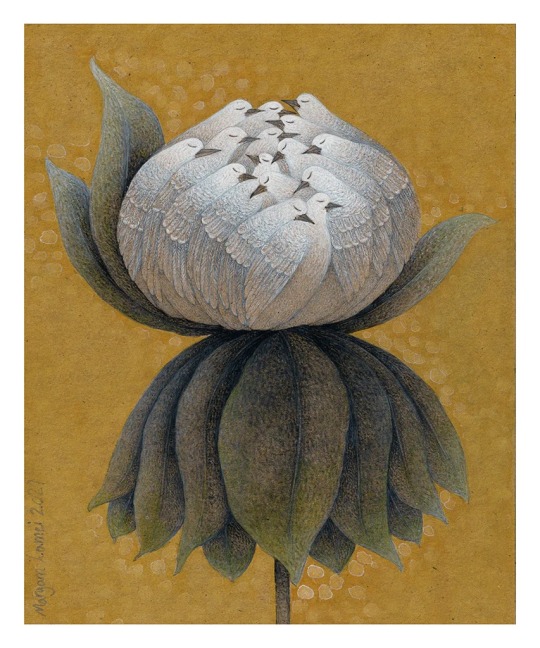
Maryam Lamei Harvani, Birds are gathered in God, 2021
Maryam Lamei Harvani was born in 1985 in Sarab, a historical city in northwest of Iran. After graduating in Graphic Design, she was awarded the National Art Prize and the art award from the Ministry of Science Research. Her work is inspired by the Iranian Golo Morgh (Flower and Bird) paintings, a traditional Persian way of painting in which the flower is the beloved and the bird is the lover. Via toiartgallery
22 notes
·
View notes
Text
Remember the nameless ones
Who survived the kiss of glacier
The years of lean and those of plenty
Whose genes slipped through pogroms
Who turned right instead of left
Whose soft, quick tongues made jokes of fate
Whose fingers shaped scraps into latkes
Who clung to their traditions, their songlines
Their medicine plants, their kinship
With Grandmother Earth, Grandfather Sky.
Blessed are the vanished ones
Whose habitat became expendable
Whose lives were extinguished by indifference
Whose pelts, horn and other body parts
Were worth more to those
Whose backs, walls and libidos they adorn
Those creeping, flying, swimming, leaping ones
Whose raucous calls, gauzy wings,
Webbed toes and gaudy hues
Will not be heard or seen again.
Give thanks to the myriad scavengers
Who scuttle and hover; who devour matter
Whose unseen industry tidies away death
Who rag-pick life from a mountain of leavings
Whose ingenuity fashions answers from decay
Whose webs and threads spin shrouds
Blessed are the wanderers who leave no trace
Who huddle under flyovers, in rotten wood
Who eat from skips and tips and gutters
Who sup from the kindness of strangers
Who sleep nightly under the infinite.
- Rachael Clyne

Artwork: "Birds are Gathered in God" (date unlisted) by MARYAM LAMEI HARVANI (Iranian, born 1985).
Acrylic on canvas
20 × 24
Maryam Lamei Harvani was born in Sarab, a historical city in Iran. After graduating in Graphic Design, she was awarded the National Art Prize and the art award from the Ministry of Science Research.
Her work is inspired by the Iranian Golo Morgh (Flower and Bird) paintings, a traditional Persian way of painting in which the flower is the beloved and the bird is the lover.”
#remember#life#heart and soul#art and soul#Rachael Clyne#birds are gathered in God#artwork#imagika#MARYAM LAMEI HARVANI
16 notes
·
View notes
Text


Sassanid helmet (6th-7th C. CE) & Luristan helmet (6th-9th C. BCE)
"The helmet housed at the Römisch Germanisches Museum in Mainz, Germany (Inv. O. 38823; Fig. 26) is dated to the late 6th-early 7th century CE. Discovered in Iran’s Amlash region, this helmet was built of bronze, silver and Iron. The Varanga “feather” (?) and/or “scale” pattern (?) is again evident as would be expected of late Sasanian helmets from the empire’s Western regions. The band enclosing the bottom area of the helmet is also decorated in the same Varanga/scale design. At the front of this area is a rectangle that has within it two vertical “sine wave” graphics. At the bottom edge of the rim can be seen punched holes, along with some cracks.
Unique in the case of this helmet is a crescent moon decoration like the one seen on Figure 25 cited previously. Atop the rectangle with the two “sine wave” designs on the helmet from Mainz is an upright crescent motif apparently based on a much earlier tradition; this is strikingly similar to the much more ancient 9th-7th century BCE one-piece domed bronze helmet (possibly Kassite in origin) excavated in Luristan (Fig. 26). At the back of the Luristan helmet is a repoussé hook and dot pattern, with a notched band of flecked triangles appearing along the border.38 The frontal decoration attached on this helmet consists of opposing mythological beast heads with a crescent ornament atop the figures. Interestingly, the Luristan helmet’s crescent motif appears in the same upright orientation as the Sasanian helmet suggesting a possible design motif spanning over 1000 years (Fig. 26)."
-Farrokh, K., Karamian, Gh., Kubic, A., & Oshterinani, M.T. (2017). An Examination of Parthian and Sasanian Military Helmets. In “Crowns, hats, turbans and helmets: Headgear in Iranian history volume I” (K. Maksymiuk & Gh. Karamian, Eds.), Siedlce University & Tehran Azad University, pp.121-163.
21 notes
·
View notes
Text
Top 4bet Betting Strategies for Success

In the evolving landscape of online gambling and sports betting, 4BetFarsi has emerged as one of the most prominent platforms catering specifically to Persian-speaking users. As access to international فوربت betting sites becomes increasingly challenging in certain regions, localized platforms like 4BetFarsi provide Iranian users with a streamlined, Persian-language interface and tailored betting opportunities that cater to their unique preferences. This article delves into the features, services, safety considerations, and advantages offered by 4BetFarsi, providing a comprehensive overview for new and experienced bettors alike.
What is 4BetFarsi?
4BetFarsi is a dedicated online sports betting and gambling platform designed specifically for users in Iran and Persian-speaking regions. It provides an extensive selection of sports markets, live betting opportunities, online casino games, and virtual sports. Unlike global platforms that may not offer language support or relevant payment methods for Iranian users, 4BetFarsi bridges the gap by delivering a localized experience.
The Appeal of 4BetFarsi
Persian Language Interface
Localized Payment Methods
Access to Popular Iranian Sports and Events
Comprehensive Sportsbook with International Coverage
Casino Games, Slots, and Live Dealers
These tailored features make 4BetFarsi a go-to platform for Iranian bettors who may face barriers accessing major international betting sites.
Key Features of 4BetFarsi:
1. Sports Betting Options: 4BetFarsi offers a wide range of sports markets, including both international leagues and local Iranian events. Users can bet on:
Football (Soccer)
Basketball
Tennis
Volleyball
Martial Arts and MMA
Horse Racing
Esports
The platform supports pre-match betting 4bet as well as live betting, allowing users to place wagers while games are in progress.
2. Online Casino Games: In addition to sports betting, 4BetFarsi’s online casino section offers a rich selection of games, including:
Slot Machines
Table Games (Roulette, Blackjack, Baccarat)
Poker Rooms
Live Dealer Games
These games feature advanced graphics and are developed by reputable gaming software providers, ensuring both entertainment value and fair play.
3. Mobile Compatibility: Recognizing the growing demand for mobile betting, 4BetFarsi offers a fully responsive mobile site, allowing users to place bets, deposit funds, and withdraw winnings directly from their smartphones. This convenience makes betting on the go easy and accessible.
4. Bonuses and Promotions: 4BetFarsi regularly offers bonuses and promotions designed to attract new users and reward loyal customers. Common promotions include:
Welcome Bonuses for New Players
Deposit Match Bonuses
Free Bets on Selected Sports Events
Casino Cashback Offers
Special Promotions for Iranian Holidays
Safety and Security
Is 4BetFarsi Safe?
Online betting platforms operating in regions 4bet سایت with strict regulations on gambling must take extra precautions to protect user data and funds. 4bet سایت 4BetFarsi implements a range of security measures, including:
SSL Encryption to protect user data during transactions.
Secure Payment Gateways tailored for Iranian users.
Anonymous Payment Methods to enhance user privacy.
Account Verification Protocols to prevent unauthorized access.
Although 4BetFarsi aims to provide a secure environment, users are encouraged to use VPNs or proxy services when accessing the platform to further enhance privacy and avoid regional internet restrictions.
Payment Methods:
Deposits and Withdrawals: One of the primary advantages of using a localized betting platform like 4BetFarsi is the availability of payment methods suited to Iranian users. These include:
Cryptocurrency Payments (Bitcoin, Tether)
E-Wallets and Digital Payment Platforms
Iranian Bank Transfer Workarounds
The use of cryptocurrencies has become increasingly popular due to their ability to bypass traditional banking restrictions on gambling-related transactions.
Responsible Gambling Features
Promoting Safe Betting Practices
4BetFarsi actively promotes responsible gambling through:
Deposit Limits
Betting Limits
Self-Exclusion Tools
Educational Resources
The platform encourages users to gamble responsibly and provides links to international organizations offering support for gambling addiction.
Legal Consideration
Understanding the Legal Landscape
Gambling laws in Iran are strict, for bet with most forms of gambling being prohibited. However, many Iranian users access online betting sites through VPN services or proxy connections. 4BetFarsi operates from offshore jurisdictions, allowing it to legally offer betting services to users residing in Iran, although users should be aware of the potential risks involved.
Tips for Safe Access
Use VPN Services to anonymize your connection.
Avoid sharing excessive personal data.
Use cryptocurrencies for maximum privacy.
Familiarize yourself with your local laws regarding online gambling.
User Experience
Ease of Navigation
4BetFarsi’s website is designed for seamless navigation, even for users new to online betting. The Persian-language interface ensures users can easily find:
Sports Markets
Betting Options
Casino Games
Account Settings
Promotions and Bonuses
Customer Support
The platform offers 24/7 customer support through:
Live Chat
Email Support
Telegram Support Channels
This ensures that users can quickly resolve issues, whether related to account verification, deposits, withdrawals, or technical difficulties.
Advantages of Choosing 4BetFarsi:
1. Localization: 4BetFarsi caters specifically 4 bet to the Iranian market, offering Persian-language support, Iranian sports markets, and familiar payment options.
2. Comprehensive Betting Options: From global sporting events to Iranian leagues and online casino games, 4BetFarsi covers the full spectrum of betting entertainment.
3. Privacy and Anonymity: With crypto-friendly payments and secure access options, users can bet privately without fear of exposure.
4. User-Centric Promotions: Regular bonuses and promotions reward both new and loyal players, enhancing the overall betting experience.
Final Thoughts:
4BetFarsi stands out as a leading online betting platform for Persian-speaking users, combining local expertise with a wide array of international betting options. With its user-friendly interface, secure payment methods, and commitment to responsible gambling, it provides a comprehensive, reliable platform for Iranian bettors who wish to enjoy the excitement of sports betting and online casinos.
0 notes
Text









The Borderless Graphic Designers Group (BGD) invites designers worldwide to create powerful posters addressing global social and political challenges.
———
Themes:
1. Bridges, Not Walls: Unity in a Divided World
2. The Narcissist’s Mirror: When Ego Shapes Policy
🇨🇦 Canadian Perspectives:
• Neighbors, Not Rivals – Canada & U.S. relations
• Stronger Together – Defending diversity in Canada
———
Important Dates:
• Contest submissions begin: Feb 17, 2025
• Deadline for submitting works: May 17, 2025
• Opening of the exhibition: Jun 09, 2025
Submit your work:
• Email: [email protected]
• Poster size: 70 × 100 cm / Dpi 150 / RGB / (JPG, max 5MB)
———
• Organizer:
Borderless Graphic Designers Group
• Competition Manager:
Reza Saeedi (Canada)
• Competition Secretary:
Hossein Mohammadi Vahidi
———
Jury Team:
Pekka Loiri (Finland)
Kye-soo Myung (South Korea)
Hitoshi Miura (Japan)
Onish Aminelahi (Usa)
Naser Nasiri (Iran)
Arafat Al-Naim (Uae)
Eric Boelts (Usa)
Helen Baranovska (Ukraine)
Eston Km (Indonesia)
———
Poster Designer: Robert Young (Canada)
———
🔗 More info: Borderlessgroup.ca
#USCanadaRelations #TradeTariffs #EconomicPolicy #CulturalIntegration #PoliticalUnity #TrumpPolicies #CanadaUSATrade #BorderIssues #NationalIdentity #GlobalPolitics #SocialImpact #DesignForChange #PosterCompetition #GraphicDesign #SocialChange #PoliticalDesign #UnityNotWalls #StrongerTogether #DiversityMatters #BorderlessDesign #GlobalDesign #CreativeVoices
#onish#onishaminelahi#aminelahi#onish_aminelahi#اونیش#اونیش امی الهی#اونیش امین اللهی#همرنگ#آتلیه امین الهی#iranian designer#iranian graphic designer
0 notes
Text
Rath Graphic: A Leading Producer of Calendars and Promotional Materials in Tehran, Iran
Rath Graphic is a publishing house based in Tehran, Iran, specializing in the design and printing of diaries, calendars, notebooks, and promotional and corporate gifts. Established in 2000, the company has grown to become a prominent producer in its field, with over two decades of experience.
Products and Services:
Diaries and Yearbooks: Rath Graphic offers a wide variety of diaries and yearbooks in diverse designs and sizes.
Calendars: The company produces various types of calendars, including wall calendars, desk calendars, and pocket calendars.
Notebooks: Rath Graphic manufactures high-quality notebooks with various designs.
Promotional and Corporate Gifts: The company provides a diverse range of promotional and corporate gifts that can be used for advertising and branding purposes.
Key Features of Rath Graphic:
Long-standing history and extensive experience in the production of printed materials.
Utilization of well-equipped and modern workshops.
Provision of high-quality products with diverse designs.
Wide variety of products and services.
Ability to provide advertising services.
Where to find their products:
You can find their products online at Iranian online retailers such as Digikala and Torob.
Their Website is: rathgraphic.com
https://www.rathgraphic.com/en/
I hope this information is helpful.
0 notes
Text

SR-71 Pilot tells why the only SAM that had a chance to hit the Blackbird was a Nuclear S-300 fired ahead of the Habu
The Blackbird
The SR-71, unofficially known as the “Blackbird,” is a long-range, advanced, strategic reconnaissance aircraft developed from the Lockheed A-12 and YF-12A aircraft. The first flight of an SR-71 took place on Dec. 22, 1964, and the first SR-71 to enter service was delivered to the 4200th (later 9th) Strategic Reconnaissance Wing at Beale Air Force Base, Calif., in January 1966.

CLICK HERE to see The Aviation Geek Club contributor Linda Sheffield’s T-shirt designs! Linda has a personal relationship with the SR-71 because her father Butch Sheffield flew the Blackbird from test flight in 1965 until 1973. Butch’s Granddaughter’s Lisa Burroughs and Susan Miller are graphic designers. They designed most of the merchandise that is for sale on Threadless. A percentage of the profits go to Flight Test Museum at Edwards Air Force Base. This nonprofit charity is personal to the Sheffield family because they are raising money to house SR-71, #955. This was the first Blackbird that Butch Sheffield flew on Oct. 4, 1965.
During its operational lifetime, the SR-71 provided intelligence about the Yom Kippur War in 1973, the Israeli invasion of Lebanon in 1982, the US raid on Libya in 1986 and the revelation of Iranian Silkworm missile batteries in 1987. The USAF ceased SR-71 operations in January 1990.
The Blackbird was designed to operate at extreme velocities and altitudes: in fact, from 80,000 feet, it could survey 100,000 square miles of Earth’s surface per hour. Achieving a radar lock on it was extremely difficult not only for any fighter jet then in service, but also for any surface-to-air (SAM) missile.
45 degrees of bank for a designated high bank turn
Thus, the rumors that the SR-71 stopped flying because it could be intercepted by jet fighters then in service with neutral countries in the Baltic or by Soviet MiGs are not true. There were so many factors in place to protect the Blackbird from being fired upon, some of which cannot be discussed in detail as they are still classified.
artwork

This print is available in multiple sizes from AircraftProfilePrints.com – CLICK HERE TO GET YOURS. Dawn at 80.000ft – SR-71 Blackbird
Former SR-71 pilot David Peters confirms this statement;
‘We were allowed 45 degrees of bank for a designated high bank turn. Radius is about 60 miles at 3.2. But your change of heading is pretty rapid you are just covering a lot of ground and air doing it. Most people don’t understand the dynamics. We were not going to outmaneuver much of anything. What matters is the proximity to start with. The speed and range of the protagonist.
‘One of the real highlights of flying above Mach 3 and above 80,000 feet is nobody is up there with you. They have to see you (radar) first. How far away is significant because we are not just larking along.
‘If you are talking surface-to-air missiles, how long does it take to launch get to 80,000 feet? How long does it take, and how close does it have to get to be able to maneuver if we are not going straight ahead?
‘Very few missiles could go far enough to make up 36 or more miles per minute.
‘All this is not taking any consideration of our ECM capability.’
SR-71 Pilot tells why the only SAM that had a chance to hit the Blackbird was a Nuclear S-300 fired ahead of the Habu
S-300 SAMs
A Nuclear S-300 fired ahead of the SR-71
Peters concludes;
‘The bottom line is the only surface-to-air missile that had any chance at all was the SA-10 [SA-10 Grumble, the NATO reporting name of the S-300 Soviet SAM system] if it was nuclear. That would allow them to fire it out ahead of us with an air burst at altitude, which we could possibly not circumvent. Airborne I.e. interceptors none had any chance what so ever.’
Be sure to check out Linda Sheffield Miller (Col Richard (Butch) Sheffield’s daughter, Col. Sheffield was an SR-71 Reconnaissance Systems Officer) Twitter X Page Habubrats SR-71, Instagram Page SR71Habubrats and Facebook Page Born into the Wilde Blue Yonder Habubrats for awesome Blackbird’s photos and stories.
@Habubrats71 via X
8 notes
·
View notes
Text
Exhibition Booth Design in Tehran
When it comes to showcasing your brand at trade shows and exhibitions, the right exhibition booth design in Tehran can make all the difference. Tehran is a bustling hub for various industries, making it an ideal location for businesses to connect with potential clients and partners. In this article, we’ll explore key elements and tips for creating an effective exhibition booth design in Tehran that attracts attention and engages visitors.

1. Understanding the Importance of Booth Design
Your booth is often the first impression potential clients have of your brand. An appealing and well-thought-out exhibition booth design in Tehran can attract foot traffic and create a welcoming atmosphere. This is crucial in a competitive environment where many companies vie for attention.
The Role of Cultural Elements
In Tehran, incorporating local cultural elements into your booth design can resonate with visitors. Think about colors, patterns, and themes that reflect Iranian culture, which can help create a connection with your audience.
2. Know Your Audience
Before you start designing your booth, it’s essential to understand who your target audience is. Knowing their interests and preferences can help you tailor your exhibition booth design in Tehran to meet their expectations.
Research Visitor Demographics
Consider the demographics of the exhibition attendees. Are they industry professionals, potential customers, or students? Understanding who will be visiting can help you decide on the layout, graphics, and interactive elements to include.
Use Feedback from Past Events
If you’ve participated in previous exhibitions in Tehran, gather feedback from attendees. This information can guide your design choices and help you understand what worked well and what didn’t.
3. Keep the Design Simple
While it can be tempting to create an elaborate booth, simplicity often leads to a more effective exhibition booth design in Tehran. A clean and organized space makes it easier for visitors to focus on your message.
Establish a Clear Focal Point
Your booth should have a clear focal point that draws attention. This could be a product display, a digital screen, or an interactive element. Make sure it communicates your brand’s message effectively.
Avoid Clutter
Avoid overcrowding your booth with too many items or graphics. A clutter-free design allows visitors to navigate your space easily and makes your key messages stand out.
4. Use Eye-Catching Graphics
Graphics are essential in any exhibition booth design in Tehran. High-quality images, bold colors, and clear messaging can capture attention and communicate your brand effectively.
Incorporate Local Themes
Consider using graphics that reflect local culture or the theme of the exhibition. This can create a deeper connection with visitors and make your booth more relatable.
Ensure Legibility
Make sure that any text in your graphics is easy to read from a distance. Use large fonts and contrasting colors to enhance visibility, ensuring that your message is clear.
5. Create an Interactive Experience
An engaging experience can set your booth apart. Consider incorporating interactive elements that allow visitors to engage with your brand in meaningful ways.
Use Technology Wisely
Incorporate technology like touch screens, VR experiences, or live demonstrations of your products. These elements can create memorable interactions and encourage visitors to spend more time at your booth.
Host Activities or Contests
Consider hosting contests or giveaways to attract visitors. These activities can create excitement and encourage attendees to engage with your booth.
6. Showcase Your Brand Effectively
Your booth should clearly represent your brand identity. This includes your visuals, messaging, and overall atmosphere.
Maintain Brand Consistency
Ensure that your exhibition booth design in Tehran reflects your brand’s identity consistently. Use your logo, color scheme, and messaging throughout your booth to reinforce brand recognition.
Highlight Unique Selling Points
Use your booth to showcase what makes your products or services unique. Whether it’s through demonstrations, testimonials, or interactive displays, make it clear why visitors should choose your brand.
7. Provide Clear Information
Visitors should be able to find information about your products or services easily. Use various formats to share key details.
Utilize Digital Displays
Incorporate digital screens that provide information about your offerings. These screens can showcase videos, presentations, or interactive content that keeps visitors engaged.
Offer Printed Materials
Have brochures, flyers, or business cards available for visitors to take home. These materials should provide additional information and include your contact details for follow-up.
8. Train Your Staff
Your booth staff plays a critical role in your success. Invest in training to ensure they are knowledgeable, friendly, and engaging.
Encourage Proactive Engagement
Staff should actively engage with visitors, asking questions and initiating conversations. A welcoming team can significantly enhance the visitor experience and encourage deeper interactions.
9. Plan for Logistics
Logistical considerations are essential when planning your exhibition booth design in Tehran. Ensure everything runs smoothly before, during, and after the event.
Assess Technical Requirements
Make a list of all technical needs, including power sources, internet access, and any equipment needed for demonstrations. Ensure you have everything ready ahead of time.
Prepare for Set-Up and Take-Down
Create a clear plan for how your booth will be set up and taken down. This will help avoid last-minute issues and ensure a smooth process.
10. Evaluate Your Success
After the event, take the time to assess the effectiveness of your exhibition booth design in Tehran. Gathering feedback and analyzing visitor interactions can provide valuable insights.
Measure Visitor Engagement
Keep track of the number of visitors to your booth and how long they spent there. This data can help you understand what aspects of your booth were most engaging.
Make Improvements for Future Events
Use the feedback and data you gather to refine your approach for future exhibitions. Whether it’s altering your layout, improving your graphics, or enhancing staff training, continuous improvement is key.
Conclusion
Exhibition booth design in Tehran offers an exciting opportunity to showcase your brand and connect with potential clients. By understanding your audience, keeping your design simple and effective, and incorporating interactive elements, you can create a booth that captures attention and drives meaningful engagement. Remember to evaluate your results and continuously refine your approach for future events. With thoughtful planning and execution, your exhibition booth design in Tehran can leave a lasting impression and help grow your business. Happy designing!
0 notes